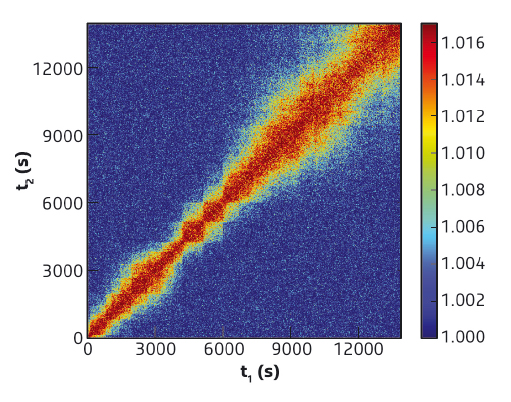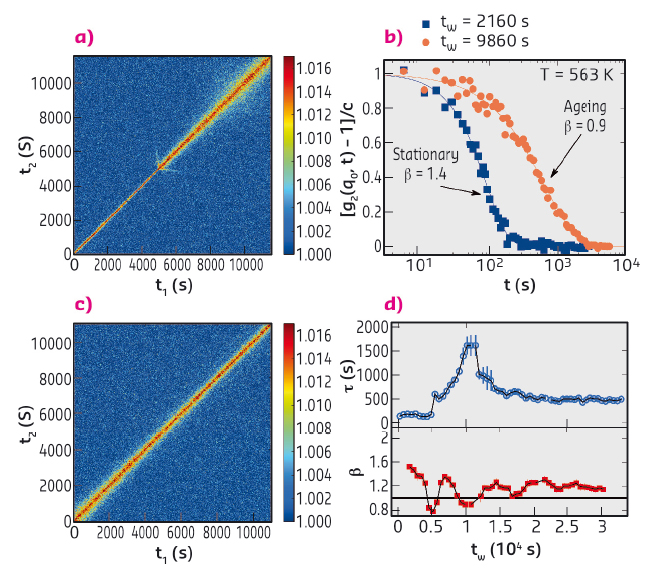- Home
- Users & Science
- Scientific Documentation
- ESRF Highlights
- ESRF Highlights 2015
- Complex systems and biomedical sciences
- Intermittent ageing dynamics in a metallic glass
Intermittent ageing dynamics in a metallic glass
Understanding how metallic glasses age on the atomic level is necessary in order to design more resilient and robust amorphous alloys. In this study, it was found that microscopic ageing occurs via a heterogeneous mechanism of intermittent atomic rearrangement and is not the steady, continuous process that has been observed in macroscopic studies.
Due to their amorphous glasslike structure, metallic glasses can exhibit remarkable and technologically-attractive properties such as a high strength and resistance to fracture. However, ageing can result in severe embrittlement and bring about profound changes to their fracture and fatigue properties. Therefore, the ability to understand and characterise the micromechanisms of ageing in metallic glasses will play a crucial role in ensuring their success in a broad range of applications. Using X-ray photon correlation spectroscopy (XPCS) at beamline ID10, we found evidence that ageing in a palladium-based metallic glass occurs in an intermittent and highly heterogeneous fashion on the atomic level.
Ageing in metallic glasses is usually investigated through the long-time equilibration of macroscopic quantities like volume and viscosity [1]. These studies show that structural relaxation occurs in a steady fashion and is described by an empirical stretched exponential function Φ(t) ∝ exp[-(t/τ)β], where t is the relaxation time and b is an exponent < 1, indicating that the relaxation proceeds more slowly than expected from a simple exponential decay. However, novel XPCS studies on metallic glasses have revealed the existence of an atomic dynamics described by compressed exponential relaxation functions (β > 1), which are characteristic of ballistic-type motions that arise from the presence of internal stresses stored into glassy (or jammed) states during structural arrest [2].
Our recent XPCS investigations shed even more light onto this unique phenomenon by showing that ageing on the atomic level does not occur in the steady and temporally homogeneous manner as revealed by macroscopic measurements. Figure 81 gives an exemplary illustration of this. The overall broadening trend of the XPCS intensity profile shows that the dynamics is slowing down significantly during annealing, as is expected from physical ageing. A remarkable feature, however, is the occurrence of rapid decorrelation events – characterised by a sudden narrowing of the intensity profile – which appear intermittently as the measurement progresses. We interpret these as signatures of the relief of atomic-level stresses, which act as important mediators in the ageing of metallic glasses.
 |
|
Fig. 81: Two-time correlation function of a palladium-based metallic glass measured during ageing at 538 K. |
We believe the origin of this unique behaviour to be rooted in the evolution of internal stresses, which are stored at the atomic level during vitrification and whose gradual release mediates physical ageing in metallic glasses. Structurally, this can be thought to correspond to localised micro-collapses of groups of particles, which trigger subsequent collapses in neighbouring regions through the formation of stress dipoles. In Figure 82 we quickly heated the partially aged metallic glass to a higher temperature, thereby observing the effect of the previous ageing on the microscopic dynamics. We notice here a long regime of fast, stationary dynamics, which is interrupted by a sudden, then gradual broadening of the intensity profile (Figure 82a). The change in β between these two regimes from 1.4 to 0.9 (Figure 82b) signals the transition from compressed to stretched exponential relaxation, suggesting a cross-over from ballistic to diffusive, liquid-like atomic motion as the glasses ages. However, complete relaxation back into the equilibrium liquid is – at least in the microscopic sense – astonishingly difficult. This is evidenced by the gradual return of β to values greater than 1, indicating that the system is still stuck in the non-equilibrium state (Figures 82 c-d).
 |
|
Fig. 82: (a) Two-time correlation function after heating the aged sample directly to 563 K. (b) Normalised one-time correlation functions calculated in the stationary and ageing regimes. (c) Two-time correlation function corresponding to the continuation of the measurement at 563 K. (d) Evolution of τ and β over the entire length of the measurement at 563 K. |
The intermittent dynamics reported here for the first time in a structural glass is indicative of a complex energy landscape, characterised by numerous minima, in which the system dwells for long periods of time in stable configurations. This is further confirmation that macroscopic and microscopic ageing in metallic glasses clearly obey different laws. Moreover, the observation of a similar intermittent dynamics over a range of physical processes such as crystallisation, deformation and shear flow suggests a universal underpinning.
Principal publication and authors
X-ray photon correlation spectroscopy reveals intermittent aging dynamics in a metallic glass, Z. Evenson (a,b), B. Ruta (c), S. Hechler (d), M. Stolpe (d), E. Pineda (e), I. Gallino (d) and R. Busch (d), Phys. Rev. Lett. 115, 175701 (2015); doi: 10.1103/PhysRevLett.115.175701.
(a) Heinz Maier-Leibnitz Zentrum (MLZ) and Physik Department, Technische Universität München (Germany)
(b) Institute of Materials Physics in Space, German Aerospace Center (DLR), Cologne (Germany)
(c) ESRF
(d) Department of Materials Science and Engineering, Saarland University, Saarbrücken (Germany)
(e) Department of Physics, Universitat Politècnica de Catalunya-BarcelonaTech, Castelldefels (Spain)
References
[1] Z. Evenson and R. Busch, Acta Mater. 59, 4404 (2011).
[2] B. Ruta et al., Phys. Rev. Lett. 109, 165701 (2012).



